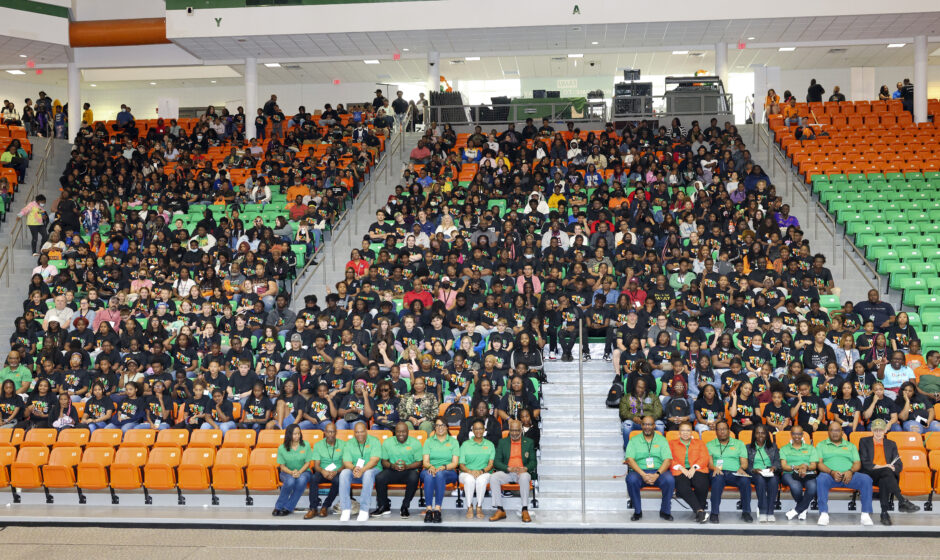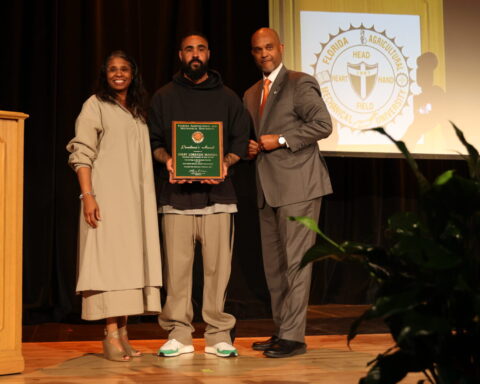By Andrew Skerritt
Florida A&M University’s 8th Annual STEM Day keynote speaker Gregory Washington, Ph.D., shared his journey from a New York City apartment to the presidency of George Mason University.
Washington earned his bachelor’s, master’s, and a doctorate in mechanical engineering from North Carolina State University in Raleigh. Before assuming his current role as head of Virginia’s largest public university, he served as engineering dean at Ohio State University and the University of California Irvine.
Washington told the young audience about being inspired to become an engineer after working with bricks in the hot North Carolina sun and meeting an engineer who worked in an air-conditioned office and was paid much better than the manual laborers and tradespeople. He urged students to learn the importance of STEM in everyday life.
“Eighty-five percent of everything that makes up this country is related to science, technology, engineering and math; 85 percent of all what we produce has a scientist or technologist, an engineer or mathematician behind it, somewhere in this process,” Washington said. “We want you to be a part of that 85 percent.”
Using images on the big screen to keep the young students engaged, Washington discussed the role of STEM in artificial intelligence (AI), a rapidly growing area of interest.
“Look at the individuals on the screen here, not a single one is real,” he said. “They have all been drawn directly by a computer, every single one of them. So the idea of copyright will go away because computers can make the images of anybody on the screen.”
In welcoming Washington and the more than 700 students to the daylong event, FAMU President Larry Robinson, Ph.D., urged them to prepare for the stiff competition to gain admission to FAMU.
“Take care of your business early and then make sure you put FAMU to the front of your list,” said Robinson, the university’s chief scientist. “We have over 20,000 first time-in-college students applying for a place in the class of 2027. That’s 20,000 who are knocking down the doors trying to get. They are incredible like you are. Do not make FAMU your second or third choice.”
STEM Day
STEM Day marked the culmination of a weeklong series of activities for the Historically Black College and Universities (HBCU) Undergraduate Program (UP) Week funded by the National Science Foundation (NSF). The initiative is part of a grant spearheaded by Chief Operating Officer Maurice Edington, Ph.D., the principal investigator; fellow principal investigator Lewis Johnson, Ph.D., associate provost for Student Success and Strategic Initiatives for Academic Affairs; co-principal investigator Desmond Stephens, Ph.D., director Faculty Development; and co-principal investigator Carl Moore, Ph.D., professor of engineering.
The events were organized by the Office of STEM Outreach, headed by Alicia Hudson, and HBCU-UP Program Manager Danielle Nicholson.
Among the week’s highlights were a Women and Girls in STEM Mentoring Event, during which about 40 female engineers, scientists, and academicians interacted with more than 200 primary, middle, and high school girls; a STEM Professional Development event and a STEM-related job fair.
Hudson said this year’s STEM Day was the first to include third, fourth, and fifth graders in the planned activities.
“Initially, we usually had 6-12 graders. But since we had third to fifth graders, the College of Education was adamant about gearing up activities to work with them,” Hudson said. “It was a great event.”
David White, Ph.D., director of the Chevron Innovation Fab Lab, had more than 120 elementary students participating in group activities in the College of Education’s Gore Complex Saturday morning. The third, fourth and fifth graders were involved with launching rockets through pneumatics, making hovercrafts, the science of magnets and magnetics and object reflection symmetry.
“The groups switched activities, so all student groups eventually did each activity,” said White. “The activities were well received by both the students and parents who attended.”





